#i love gm opposed rolls
Explore tagged Tumblr posts
Text

hiiiiiiii
#bell.txt#liveblogging#natal macabro#cellbit#guaxinim#him carrying his mic packs over LMAO#i love gm opposed rolls
15 notes
·
View notes
Text
THEME: Mermaids
This week’s games are all about swimming, stabbing, and sinking ships as creatures of the open ocean - or at least, a local body of water.








Siren Silk, by DOCTOR_dev.
Players take the roles of journeyfolk, the umbrella term for travelers that spread word and wares under the waters of the Swiften Sea, home of the branchia and their kingdom Ornata. Trade is done through any number of means: you can barter goods, harvest and deliver natural resources, craft at your traveling workshop, spin stories, or deliver news to the fringe settlements of Ornata.
Siren Silk is still a work in progress, but it has more than just mermaids on offer. You can play as various kinds of undersea folk, including sirens, krakens and sea serpents. Siren Silk is built on the Passkey System, which offers a diceless way to play, using something called EP. You have stat pools with various amounts of EP, which you can spend in order to gain a success; spend more EP, get a more effective success. You can also gain advantage or disadvantage in certain situations, which gives you discounts or higher EP costs. Your PCs might also take on conditions throughout their adventures that help or hinder them in mechanical ways, such as granting disadvantage, giving you extra EP, etc.
If you want to play this game with dice, there’s also a dice-rolling set of rules that correspond to the spending of EP, so I think Siren Silk has the potential to be flexible to your table.
Siren Squad, by Jennafiggers.
The Cerulean Sea needs your help! Join the Siren Squad, where you and your friends are rainbow mermaid secret agents. Summon adorable sea creatures, solve puzzles and explore for clues until you complete your Mission to keep the sea safe. This is a world where magic and technology intertwine, all sorts of fantastic sea creatures thrive, and friendship is the most powerful force of all.
Siren Squad is a cinematic game reminiscent of American Saturday morning cartoons where the heroes win and everything goes back to normal at the end of the episode. If you love the puny, light action of Totally Spies or Powerpuff Girls, the thematic characters of Streetsharks or Skylanders, or the off-the-wall adventures of Chalkzone and Ruby Gloom, you'll probably love this game.
This game is currently in play testing form, but the designers certainly seem to have high hopes for it! You appear to construct your character from a playbook, that is heavily themed to make each PC feel unique, powerful and dynamic. Right now there appears to be google sheet versions of the playbooks, which hold Quickstart characters for people who want to get a bit of a peek into the game before committing to purchasing. One of the cutest things in this game is the existence of buddy beasts! I have no idea how they work but the art for them is very very cute.
Storm Drain Mermaids, by Papertigress.
You are a feral mermaid. You and your sister sirens (the other players) live in the local city/urban waterways, each having a territory and rallying together in flood/drought/calamity situations for survival as needed…
Now is one of those times.
This is a simple one-page game that can be printed off and double as a character sheet for each player. Your mermaid has 5 stats, and a territory that “belongs” to you and therefore gives you an advantage when you act while within it. Each player also has a pool of “scales” that can be used to improve their chances with every roll, or to inflict penalties on an opposing force. The game feels balanced between chance and the spending of resources to ensure your character succeeds a healthy amount of the time. There’s also roll tables a-plenty here, to help the GM come up with ideas as the players swim through the world.
Under the Sea, by rzut-na-angielski
Over the years the story of The Little Mermaid and her horrid end was a cautionary tale for young merfolk. But you - a group of teenage friends - think that Ariel was right. Humans are sexy. Especially the one you’ve been stalking for the past month. If you can’t go up there, then you’ll have to make sure that your human gets to live under the sea with all of you. Play to hatch a polyglamorous plan to get your human some gills AND MAKE THEM FALL HEAD OVER FINS FOR ALL OF YOU!
A goofy game about falling in love and trying to get your crush to like you back, Under the Sea is 2 pages long and grants your character three simple stats: Fins, Heart and Mind. You also carry with you some kind of magic, although how you wield that magic appears to be up to player interpretation.
The game has a very clear endgame scenario: your Human mast have gills and/or be in love with you by the end of the game, or they will die / return to the surface world, never to be wooed again. The course of the game runs over three stages: finding your human, approaching them, and bringing them to the sea (where hopefully, they will fall in love).
Guardians of the Sea, by Ezra Tellington.
"Mermaids used to live in harmony with nature and, for the most parts, humans. Sure, homo sapiens sapiens was both nutritious and easy to charm, but mermaids held no animosity towards their prey. In the last century, though, everything changed: oil spills, plastics, whole species of plants and animals eradicated, what was one day an underwater paradise began to look like a wet wasteland. Mermaid population began to shrink and the remaining ones moved to further removed regions, where humans and their trash could not find them.
In the anarchist society of mermaids emerged harsh discussions: should they wage an actual war against humanity to defend their ecosystem? Some individuals insist that not all humans are at fault, but this opinion is getting less and less popular as the marine animals die out."
Guardians of the Sea looks to be a short game, approximately 9 pages long. The character skills appear to exist as rows of pips, similar to World of Darkness, which might be easy to manage visually. The game itself is mostly about capitalism and ecology; a war rising from the ocean as the onset of climate change makes your characters’ homes uninhabitable. If you like stories that have a little bit of revenge in them, you might like this game.
A Salt Kiss Remains by Whimsy Machine.
A Salt Kiss Remains is game of mermaids, magic, and monsters in the great open sea and the land it crashes upon. We play as denizens of the ocean or other aquatic environments, exploring and protecting this world. These adventures can be lighthearted and fun, exploring sunken ruins of ancient humans, falling in love, and building families, and they can reach like the sea ever deeper. In these dark depths, we explore the damage humans cause to the oceans, what it means to be predator and prey, and the unfathomable mysteries of this vast world.
A Salt Kiss Remains may still be in alpha, but it is FULL of moves, in a way that feels slightly reminiscent of Apocalypse World. Each move references a specific situation in the game, and some of them specifically use a resource called corruption in order to help your mermaids to magical things. This includes (but is not limited to), sapping all life from a location, reading the entrails of dead creatures as a form of augury, and warping the forms of other creatures to your will.
The game also comes with a set of introductory adventures, which may be helpful for GM’s who want a solid place to start, or even just some inspiration for the kinds of stories you can tell with A Salt Kiss Remains.
Radioactive Mermaids of the Burning Sargasso, by kumada1.
In the year 2020, the world was veiled in darkness. The wind stopped. The sea was wild. The earth began to rot. And humanity went into decline. Five thousand and fifty three years have passed since then. It is now the year 2021. Life clings desperately to the ocean.
Two things are true: you are a mermaid, and you are rad.
Specifically, you are a radiotrophic being, feeding on the hazardous background noise of the universe to fuel your cool powers.
In the oceanic zone where you live, the Burning Sargasso, you are unique among lifeforms. Most creatures here are radiation-resistant, but you actively absorb and neutralize it. This makes you something of a keystone species. It also gives you potent science-magic powers, and one heck of an obligation.
Radioactive Mermaids of the Sargasso revolves around building an enclave in the sargasso and improving it, for both your sake and the sake of the wildlife around you. You’ll collaboratively define the elements of your enclave, and work together to make it flourish. Tending to the garden doles out Tedium to the caretakers, which can force your mermaid to leave the enclave if they accrue too much - eventually freedom becomes too alluring to resist. Your character might also accrue something called Rads, which don’t harm you, but can be used to fuel your science-magic powers.
If you want a unique take on mermaids and a collective, clear goal, you might want to check out Radioactive Mermaids of the Sargasso.
Seven Deadly Sirens by Litza Bronwyn.
In this game, you play one of seven types of mermaids and roll with seven deadly sins to power your basic and special moves in order to summon ships, lure men to you, devour their hearts, and collect their treasures.
Previously released, this second version of the game contains updated information based on playtesting feedback, beautiful stock imagery, and new formatting.
Each of the seven playbooks comes with a section for describing your character, filling out the bonuses for your seven sins (used as stats), relationship questions, special moves, and a place to keep track of your wounds, experience, how much treasure you've collected, and how many hearts you've devoured (which you can use to enhance more powerful moves).
Seven Deadly Sirens feels the most gritty on this list, with bonuses and negatives for various moves being determined by your Sins, which measure things such as your desire for sex, food, possessions, etc. You are all different kinds of mermaids, inspired by various sea creatures, granting you unique moves that match your playbook - such as the mer-eel, who is slippery and has a unique relationship with lightning.
This game also highlights relationships, both between the PCs and the men they will encounter. Men are cruel and lovely; they are potential lovers, victims, opponents, and so much more. Will you consume them? Or will they consume you? Play to find out.
20 notes
·
View notes
Text
It's my birthday
and the thing you can do to celebrate is check out Spindlewheel, a tarot-like storytelling system where you weave a story from card to card.
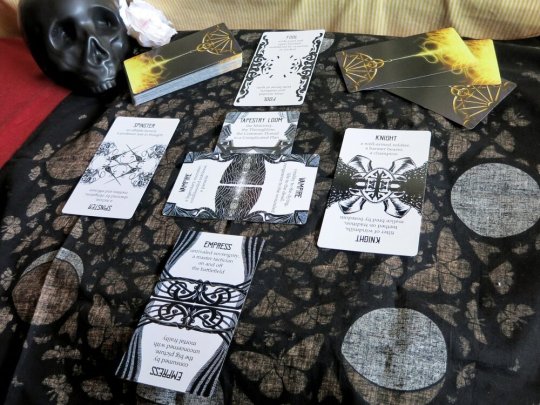
Spindlewheel is a unique system where the deck has as much to say about the story as you do, but the story is bespoke to you and your friends every time. Every Spindlewheel game is a constructed scaffolding for story structure, ranging from western four-act stories in Spindlewheel Classic, to tense bombastic duels to the bitter end in Meet Me In The Field of Honour At Dawn, to sorting out a trio's complicated feelings for each other in Love Machine.
The goal of Spindlewheel is to tell a satisfying story. Your character might win wealth and fame, or they might crash and burn. Both of these are victories if they fit the arc of the story you’ve told, and bring satisfaction to you as a storyteller.
How do you play? Well, I'm glad you asked!
Spindlewheel’s fundamental verb is interpretation.
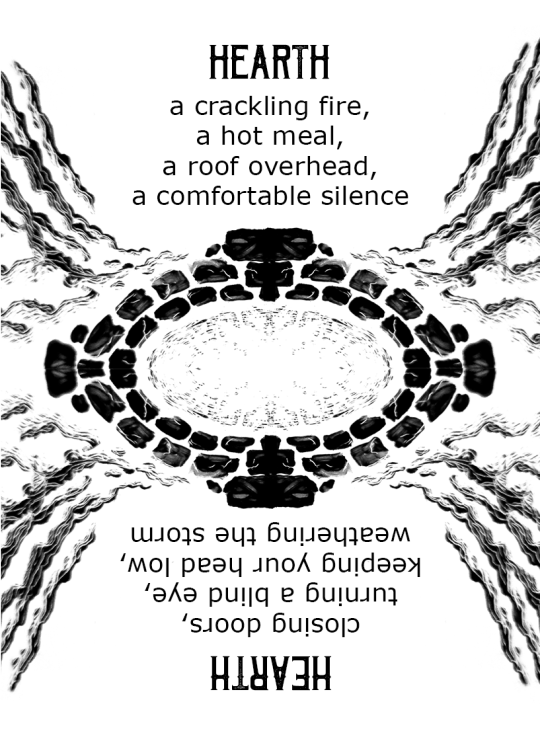
Each card’s text evokes an idea. The upright and inverse text are different. Sometimes they’re diametrically opposed; often, they’re two sides of the same coin.
Use the card as an anchor for the part of the story that you’re telling.
A card can be a person, an event, an attitude, or a physical object. Use as much as the entire card, or as little as a single word. A card is interpreted twice: once when it enters your hand, and again when you play it. It does not have to be the same interpretation.
FOR EXAMPLE: I might draw the Hearth card and Reflect that I feel like people closed their doors to me; but I might Engage that card later, declaring I won’t do the same to someone else, and play it to invite someone into my home.

It's a really excellent one shot system: it takes no prep, every setting is procedurally generated for each table, and most games are GMless. The games that are GMed are designed to support improvisation and provide coherent throughlines so the GM can focus on moment to moment play. It also works as a GM tool within other systems for when you need an ominous portent or an answer to a question where a dice roll just won't cut it.
It also makes for pretty damn good radio. Check it out on Party of One, An Atlas of the World Unknown, You Don't Meet In An Inn, Follow the Leader, and played extensively in the devlog Spindlewheel Stories where you can listen as the game takes shape over time.
Did I mention it's got an open SRD? Anyone can hack the system and sell their games. Here's a collection of people who have done just that!
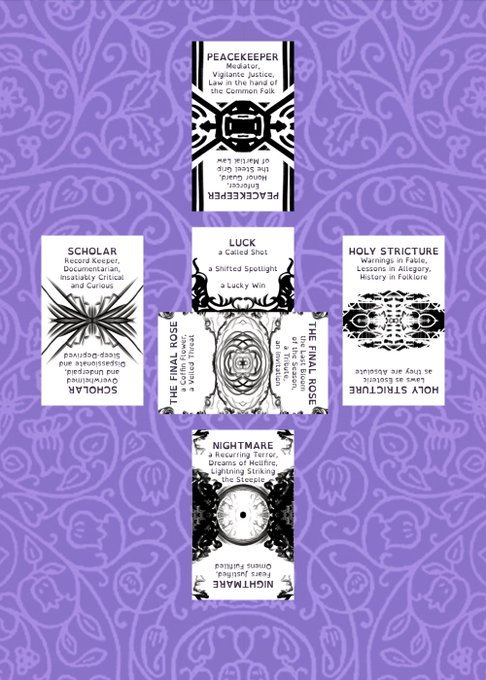
Curious?
There's lots of ways to try Spindlewheel online for free! give @spindlewheelbot (by Caro Asercion) on twitter an @ for a "classic" spread inspired by the celtic cross, or a single card "vibe check"; print and play the deck with the original legacy art or play it on playingcards.io; or play it on Tabletop Playground and Tabletop Simulator.
Convinced?
Head over to www.teacabbage.com/spindlewheel to pick your digital copy of Spindlewheel on itch.io and roll20!
#spindlewheel#indie ttrpg#tabletop#tarot#gmless#been meaning to make this post for a while#sorry my whole life is wrapped up in this game if you're tired of hearing about it but also: it's a good game so idc
325 notes
·
View notes
Text
Character-first Fantasy TTRPGs
Games like Lancer, Gubat Banwa, ICON, Draw Steel, Daggerheart, even Fabula Ultima sometimes get described as "4E Inspired."
I think that's true in a broad sense, but there's something deeper that connects all of these games that 4E doesn't have, and that's a respect for the narrative journey of the characters.
None of the games I've listed have the traditional "Death Saving Throw." You never have to tear up your character sheet because a Skeleton got a lucky Crit in the first combat of the game, and the Bard didn't have Healing Word prepped.
Each of these games either give the player mechanical choices to choose how close to death their character ever gets (Lancer, Daggerheart, Draw Steel) or they make the consequences of defeat entirely narrative (Gubat Banwa, ICON, Fabula Ultima).
World-first vs. Character-first
I was having difficulty putting this categorization to words until I read a post from makapatag, the author of the aforementioned Gubat Banwa. In that article, he lays out a way of thinking about OSR games as being "World-first," as opposed to games like D&D, Exalted, and Lancer which are "Character-first." In World-first games, the character is never so powerful that they can override the dangers of the environment. They have to adapt to the setting to survive.
I understand the allure of this type of play, especially from the GM's standpoint. But at the same time, I find that I am most comfortable when I am at least sharing in the direction of the narrative. When the game has rules that put the players' characters in the driver's seat of the narrative, it lessens the burden on the GM to tell a story, but expects more of the players in return.
Bizarro-OSR
So in this way, "Character-first Fantasy" works as a sort of "Anti-OSR," a celebration of powerful PCs running roughshod in a fantastical sandbox. Not exactly a "New School Renaissance" though, because these ideas aren't necessarily new.
I think this style of play describes how a lot of people approach D&D 5E, since it has a lot of rules that describe abilities and spells that make the players increasingly harder to corral as they gain levels.
At the same time, I think games like 5E and Pathfinder have their feet planted too far in the past to consider either of them to be truly a part of this genre. Both have very punishing death mechanics that can turn seemingly easy encounters into painful death spirals that lead to torn-up character sheets.
The Only Time I Was Ever Happy
I can't stress enough just how much it changed the game to play a Warforged for the first time in D&D 4th Edition. In that edition, Warforged have a rule that they can never roll lower than 10 on their death saving throws. That meant that unless they were being actively attacked while knocked out, they would never just "bleed out."
When I didn't have to worry about losing my character, I could take risks that I thought a "Superhero" would take. It led to me getting my ass beat mercilessly, on many occasions, but I think that's what a hero would do: They would take on any amount of suffering if they believed it would make the world a better place for the people they loved.
Power Fantasy?
You could maybe classify this style of game as being strictly based around Power Fantasy. But I think it's more about the rules supporting the player's exploration of their concept than strictly being about overpowering every obstacle put in front of you.
In any game that is trying to tell the story of a character, there have to be ups and downs. I don't think it's either necessary, or even good for the players to always win. But as long as the mechanics of the game aren't punishing you for being defeated, you have more freedom to push yourself for the sake of the narrative.
Some people derisively refer to this style of play as "Superhero" fantasy, and I don't think that's necessarily incorrect, but... It's also fun. There's nothing inherently wrong with letting your players romp around in giant robots, as long as they acknowledge the responsibility they've just been handed.
When you play in a very punishing adventure or system for the first time, you realize quickly that farting around will get you killed. Enjoy sitting out the rest of the adventure because you tried to do a skateboard trick over that Iron Golem, smarty pants.
It makes that feeling of power in a more Character-centric game that much more rewarding. But you also realize just how hard it is for the GM to keep you reeled in. In these games, it's very important for open collaboration between the GM and the players. It's really hard for the GM of a Character-centric game to plan a narrative when the players can constantly kick down the walls of the setting that are supposed to be constraints to them.
Rules-Medium?
One of the biggest changes D&D made in the leap from 4th to 5th was an overhaul of the rules that left a lot more room for narrative improvisation than 4th Edition or even Pathfinder.
That's not to say that these games necessarily need a rules-light approach. The important thing connecting them is that the rules support the fantasy that the characters represent. If my character is good at fighting, I want mechanics that help to reflect that in the game world, without resorting to handwaving.
For this reason, I think a lot of more "fiction-first" games in the PbtA or FitD mechanical genre get disqualified here. They tend to focus a lot on the narrative consequences of the interactions between the characters and the setting, and frame the players' powers less as "tools to conquer the setting" and more as "prescriptive ways to move toward your goals in a narrative-appropriate way." Does that make sense?
For a true rules-light approach to this budding genre of ttrpg, I would check out any game in the LUMEN system family of games from Spencer Campbell at Gila RPGs. I'm excitedly anticipating my Kickstarter copy of Infinite Revolution from Gwendolyn Clark to arrive, I think that game is going to really kick ass.
Well, Anyways
I wrote a lot of this on not a lot of sleep. My mind has been racing, trying to put a lot of these ideas to words. The aforementioned blog by makapatag really helped to put a lot of my thoughts about the current (and future) state of Fantasy into focus.
It's entirely possible, also, that this idea is not new. I'm sure there's someone out there who has had the same thought as me, and my lazy ass never actually tried to find their writing. Instead I just wrote it out again, because I'm a huge PIECE OF CRAP.
Anyways, sleepy tea is kicking in, good night.
#daggerheart#mcdm#dnd5e#dnd#fabula ultima#ttrpg#draw steel#gubat banwa#lancer#lumen#icon ttrpg#infinite revolution#character fantasy
11 notes
·
View notes
Text
Sewer Monsters in Love
Sewer Monsters in Love, 21185Lalande, 2021
The "three kobolds in a trenchcoat" joke is pretty familiar these days, but fewer people remember Benjamin Grimm using the same flimsy disguise. This is a shame, because it's a much better fit for the premise of Sewer Monsters in Love (SMiL).
You, as the title says, are a sewer monster. You are in love with someone who lives Above, and you dream of even just being able to tell them. In order to live your dream, you are wearing a trenchcoat and a fedora (no, not a trilby, a fedora) and leaving your peaceful home to learn how to live amongst the humans.
And when they say "sewer monster", they mean something less Creature from the Black Lagoon and more Dianoga or Shambling Mound.
The game's weak point is character creation. There are five defaults (Man-Thing, Dianoga, Worm that Walks, King Rat, semi-anthropomorphic albino alligator) and you're told "make it up from there." The system is simple in the "gets out of your way" manner that I generally don't care for, but which is at least not broken. 2d10 + two stats + one skill + dice for bonuses, everything's an opposed roll, there's one "toughness" pool that is both your hit points and your emotional fortitude. When your toughness goes to zero, you slink back into the sewers for the night.
The art is not just the strong point, it's the centerpiece. The game is done in the style of a graphic novel, with the rules as text pages sandwiched between a comic of the monsters doing their thing, which is interspersed with a comic of people playing the game. It's done well. I've read enough awful examples of play to be genuinely surprised at how well SMiL is written. The art is in two different styles, but by a single artist. Their work is reminiscent of Joe Kubert for the monsters, and Fiona Staples for the framing story.
This game helped remind me that itch.io is not just a madhouse of ten million one-pagers, it also has some amazing work by some very dedicated people. 21185Lalande, in addition to being a red dwarf 8.3 light years away from us, is just the writer/publisher. The rest of the team is the artist, 411Gliese (same star), and main playtest GM HD95735 (again, same star). Lord I wish I had a playtest GM for my own game design.
#ttrpg#imaginary#indie ttrpg#rpg#review#the swamp thing movies are really bizarre but not in the good way that actual swamp thing is#yes yes giant-sized man-thing we've all heard it
14 notes
·
View notes
Text
Mako in the Avatar Legends: Republic City Setting Toolkit
Ok so I've mentioned a few times I'm deep into Avatar Legends, running a game with my irl dnd group. It's my first time really GMing anything and it's been a wild ride but I'm having so much fun (and my players say they are too, but my imposter syndrome makes me question it haha).
I'm cutting this because it got extremely long and it's just incoherent rambling about Mako and the game.
I just downloaded my preordered pdf of the newest book for the game, Republic City Setting Toolkit. I have not read the whole thing in depth because holy shit is it detailed and involved. tons of info about the actual city and its districts, business, government, etc. But they also introduced some very detailed mechanics for Pro-Bending, vehicles and Mechs. And when I say detailed.... Like i tried to read the pro-bending rules and I literally had to stop because it was so detailed that my brain couldn't process it at the moment- from the rules of the actual matches in the fiction, to a whole new gameplay mechanic for players, moves and techniques, and even tournament structures. There's rules for vehicle racing and chases, and combat incorporating vehicles. and mechanics for piloting mechs.. its just like SO MUCH and I'm excited to get into it but it will take my brain a while to comprehend all of it.
But of course after I went cross-eyed reading that I'm like, lets just jump to the premade adventure at the end and all the new NPCs: Bolin, Lin, Zhu Li, Iroh, and of course our beloved Mako.
The first thing I want to talk about is Mako's principle. In the game, there is a mechanic called "Balance". For PCs, they get two opposing principles and they have to pay attention to their actions throughout the game keeping their two opposing principles in balance with one another and not favoring one over the other too much. It's a whole mechanic that can sometimes give them advantages or disadvantages in rolls. Each NPC gets only one principle- (NPCs work differently and there isn't a focus on their inner turmoil or conflict about their actions the way it is for PCs, so the one principle serves an NPC just fine)
Mako's principle is a new one that I haven't seen in an NPC yet- Family. It's just perfect- particularly because throughout the character sheet it clarifies that, to Mako, family means both biological family and found or chosen family. In the instructions on how to roleplay as Mako, the first suggestion says "Put family first. Family, whether biological or chosen, is always Mako’s priority. Whether he has to enforce the law or bend it to protect loved ones, he does whatever it takes."
NPCs also get a drive (just a quick blurb to help the GM portray them, making sure to always have them act toward their drive), Mako's is "To defend and provide for his loved ones".
The next thing I want to talk about is his combat techniques. The game has a mechanic for combat, called "Combat Exchanges". It's got very specific, step by step rules for how each exchange plays out, but essentially each exchange is where the characters come together, exchange a series of blows, then breaking apart for a moment (and then either entering another exchange or ending the combat with different moves or actions or whatever). Combat imposes positive and negative statuses, each of which has rules that will affect what the character can and can't do in the fiction.
Mako has two techniques that are available to PCs- Lightning Blast and Fire Blade. Self explanatory attacks, no need to explain the mechanics. He can hurl lightning and slash with a blade of fire.
But his third technique is one that is not available to PCs- it's called "Indomitable Will" and it's incredibly powerful. "Push yourself to overcome anything holding you back" is the first sentence in the description. I'll try not to get too dry with the gameplay mechanics, but what makes it powerful is: first, it is in a category called "Defend and Maneuver". PCs and NPCs who use defend and maneuver techniques go first in the order, so he gets to use it before anyone can actually attack him. The ability lets him immediately use any other ability he knows, while ignoring any negative status effects. Then he gets to clear a negative status of his choice.
This is basically what he does when Amon blood bends him in season one. Before Amon can take his bending, Mako uses his sheer force of will to ignore the negative status of being "trapped" by Amon's bloodbending, blasts him with lightning, which then frees him of being 'trapped', effectively clearing the condition. Like. Absolutely amazing. I recently reblogged something about his super powerful bending, and like, this technique is a perfect demonstration of that.
In the Premade adventure of this book, "The Quick and the Quarrelsome", Mako is the one who sets the PCs on the path of the adventure. The adventure is all about illegal racing in the tunnels beneath the city. Mako calls on a the PCs to square away a favor they owe him (starting the session involves all the players answering questions about how they know Mako and what situation he had helped them with leading to them owing him one). He has been keeping an eye on the illegal racing, in particular the street kids who run the whole thing, who call themselves the Badgermole Triad. Due to a myriad of political reasons, the police are about to crack down on the races (Up til now, Beifong has turned a blind eye because the racing is underground where it isn't really affecting anyone but the racers). Mako apparently has a soft spot for these kids and doesn't want them to get in trouble, but his hands are tied, so he asks the PCs to infiltrate the races and help the Badgermole Triads possibly turn to legitimate racing before they are arrested. (or whatever other solution manages to come out of how the adventure goes)
I love everything about this, Mako looking out for street kids, Mako having helped the PCs out of something in the past, and of course the fact that it's the Badgermole triad he's helping out. Wu is probably rooting for these kids too, if not for any other reason than their taste in triad name.
Mako's character sheet also firmly establishes him as a workaholic which should come as no surprise. He basically never relaxes except if his friends force him to or if he decides to catch a pro-bending match to relive his days in the arena.
I haven't decided if I'm going to run this adventure for my players yet but if I do I'm both nervous and excited to roleplay as Mako, even for a short time. I already had to roleplay as Varrick at the conclusion of the Water and Mist adventure, and THAT was a trip, let me tell you. Mako is like, a normal guy so it will probably be easier, but still. I still get shaky about portraying NPCs, in particular the characters that already exist in the show!
If you've read this far, thank you for letting me wordvomit all of my Mako thoughts into one place. Now that I've got that out of my system, I'm going actually read the book and plan for the next session of my game haha
19 notes
·
View notes
Text
XD!
youtube
Actually, I think this is really why I prefer to GM as opposed to play.
Because for me, the fun is all in rolling with this sort of thing.
You want to seduce the dragon. Risky. Dangerous. Bold plan. Roll for it.
Success?
Ok.
No, you don't have to roll up a new character. And you are way more precious than gold. So, it's not that you're trapped in the cave forever, it's that you have to justify leaving the safety of the hoard and then you have to provide for the giant lethal love you've acquired.
This relationship is getting centered.
And I am now going to spend the next dozen sessions doing my damndest to make you fall in love with the dragon, so that when the inevitable dragon slayers show up, you're going to charge head first into battle without even questioning it... plunging you into even more trouble.
XD - and Anima says anyone who treats every single item in a hoard as equal doesn't understand dragons. Yes, they're ALL precious, and you thieving heroes can't have ANY of her treasures. But the heart of a Hoard gets followed. And that's what you are now. So... hope the inn has a LOT of livestock for dinner.
1 note
·
View note
Text
So I've taken a vow to move my RPG reviews/rambles to my Tumblr, and I'm willing to bet someone after this week might be in the market for some new indie fantasy RPG -- especially one that isn't using the OGL. So let me tell you about EYES BEYOND THE TORCHLIGHT!
Disclaimer: I originally reviewed this on Twitter months ago,and have decided to put it all together here in support of this game I love.
SUMMARY:
It's a fantasy heartbreaker. It has 4 archetypes (Cleric, Mage, Rogue & Warrior) and familiar fantasy ancestries (Dwarf, Elf, Gnome, Halfling, Half-Elf, Half-Orc, and Human). It has dungeons, dragons, & themes that will surprise nobody. But it's the approach to game mechanics I've been enjoying.
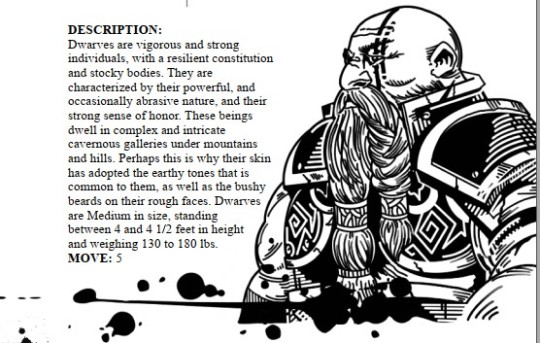
The core mechanic is d20+Stat vs 12. The catch is that stats are rated in dice, from d4 to d12. There also "Boosts" and "Setbacks" that add or subtract d6s to the total. The system is player facing, with some fun twists.
For example: on successful attack rolls, the value of the Stat Die determines the amount of damage dealt to the target. On unsuccessful defense rolls, your Stat die determines how much damage is soaked (on successful defense rolls, you dodge completely). Enemies have flat damage values -- this is all one roll and go.
Character Creation is fun and flexible. It doesn't inundate a newcomer with too many choices, but it gives a lot of room to build on a theme. Your choice of ancestry and archetype provides starting Edges, and you can choose to gain extras by taking on Hindrances.
Edges & Hindrances are pretty straight forward. They give boosts (or setbacks), raise (or lower) a Stat Die in a situation, or establish a factoid feature or flaw in the narrative. These are all interesting choices, and not "build theory" number tweaks like feats in DND.
I should also note here: there's only 4 stats (Brawn, Agility, Intellect, Presence) and some derivatives (Hit Points, Armor, Initiative & Movement). Oh, and there's HERO POINTS! (Your luck/cool point meta-currency that lets you re-roll or do cool things).
Then there's Backgrounds. Your Background actually functions as your "skill" set -- any non-combat roll associated with it gets a Boost.
Let's talk a bit about what there's not -- NO LEVELS! At least, not proper (there are "tiers" of characters). At the end of every adventure, you get Advancement points. You spend these to raise stats, buy off hindrances or acquire edges. The character progression is pretty open.
One of my players was an Ugly Dwarf Pirate, whose punching attacks deal lethal damage. His companion is a Half-Elf Warrior Poet, who can shapeshift into small animals. Tell me that doesn't sound badass out the gate!
The game also has a pretty complete bestiary of traditional fantasy game monsters, although it skimps details and expects you to already be familiar with them from other games. But hey: stat blocks for them fit on a notecard, which is my most desired aspect as a GM!
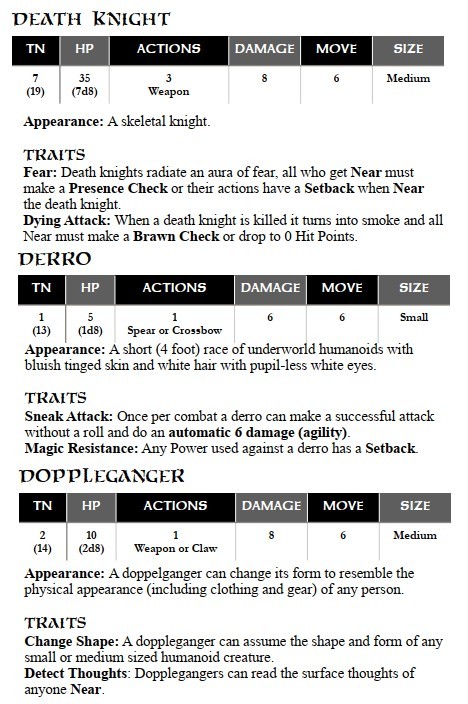
I should mention that every monster is listed with a "Threat Number" -- this is the penalty to actions opposing them. You have two choices: add the Threat to the base 12 target number or subtract it from a player's roll instead (whichever is easier).
Now let's talk POWERS -- aka magic. Powers are spells, and once you learn one you keep it. You roll dice when you cast; should you fail you have the option to either take damage OR "burn" the spell to cast it (can't cast it again until you rest).
There's a good list of Powers here, but not a crazy tome like other fantasy games have. Most are utility, with a few combat-based ones. Your token Area of Effect spell "Blast" is dangerous -- it targets EVERYTHING in an area. Fire it off in a mine you risk a cave in.
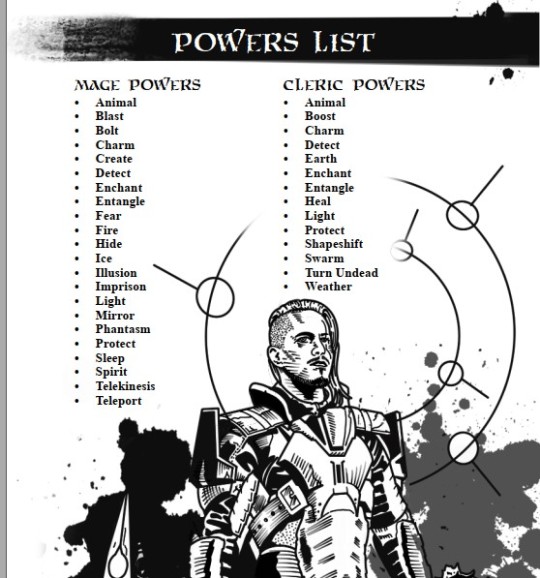
Blast and other spells also have consequences should you roll 1's on both the d20 and your Stat Die. In this case: your caster *literally explodes and dies* while also harming nearby people. Thankfully not all powers are this risky!
Anyway, plenty of treasure and magical items provided in these rules as well. Anyone can pick up a scroll or potion as a single-use power. There's your usual magical arms and armor, rings that do cool things like teleport you, grant 3 wishes, command elementals etc.
Finally, the rules come with a sample setting and adventure. The setting is a free city on the borderlands between warring nations, with ruins and monsters about. Again, not breaking any molds, but it's pretty cool and has a lot of loose hooks to build a campaign on.
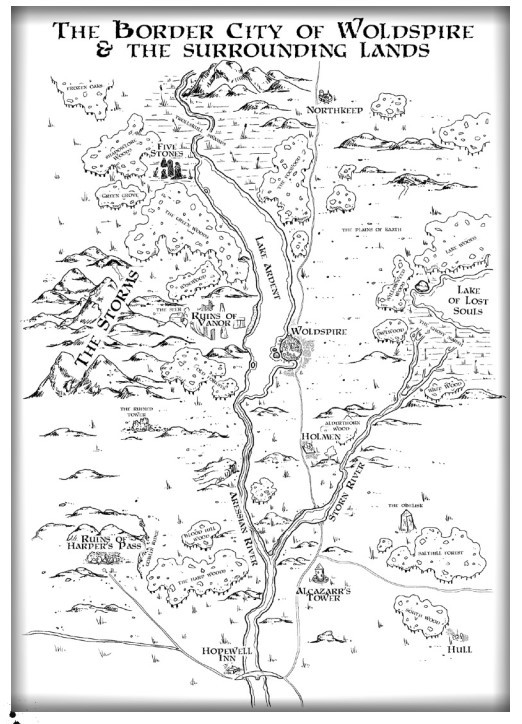
So, to wrap this up: EYES BEYOND THE TORCHLIGHT is RPG comfort food to me. I love the dice mechanics, and how easy it is to hack new content into it. Flexible & interesting player facing mechanics means it's easy to run online. It has old-school vibes without the baggage. Scott Myer wrote and illustrated this game, and now it's in the hands of the folks at MAX HP who seem to be pretty cool as well. PS -- there's an SRD for the Target 12 System that it's built on, and released under Creative Commons.
10 notes
·
View notes
Text
All of these are very good and valid takes, and I absolutely do not want what I'm about to say to come across as arguing with any of it, rather I'm using it as a jumping off point to talk about my experience with Pendragon. For those of you who are unfamiliar, Pendragon is an rpg based on the Arthurian mythos that features a system called "traits" which means "personality traits", rather than physical or mental, as other games often use them. In pendragon's case, each trait is paired with an opposing one, so "energetic" is paired with "lazy" and "valorous" is paired with "cowardly". The default in the game is to roll skill checks in the same way you might in any other BRP game, but occasionally, the GM or you as the player can determine that this circumstance calls for a trait check, and roll a relevant trait. Let's take "Valorous\cowardly" as an example. If you're going up against a really tough enemy, your gm might ask you to roll that trait pair. If one trait is substantially bigger than the other, you have to roll that one first, and if you roll under it, you must act in accordance with your trait. So if you roll a 15 and your valorous trait is 16, congrats, you act with valor. If, however, you were to roll a 17 on that check, you'd then roll against your cowardly stat (4 in this case, traits must always add up to 20) and if you roll under THAT trait, you've got to act according to it instead. Many situations in the game will require these trait checks, and I was *so* annoyed with this as a concept when I first encountered it. "Surely, if I'm playing my own character, I should be allowed to dictate how they act!" I thought. Hearing SO MANY industry vets talk about how much they loved it convinced me to give it another shot, and I've done a full 180 on it. In the same way that your rogue will not always be able to pick a given lock, despite that being the *one* thing you've specced into, your valorous knight should probably not be able to simply do the right thing every time with no chance of being tempted or swayed. This lets players really tackle the kind of character who strives to be a hero, and occasionally, often even, falls short. It allows for a richness and a texture to your roleplaying that I haven't seen in any other system, and all of that was to say that "your gm should be able to tell you that you're angry, actually, it fuckin slaps"
That @prokopetz post I just reblogged reminded me of a post I once saw on here, the thesis of which was something along the lines of "why do people criticize D&D for not having deep social mechanics? I can't see the point of having a system where characters, like, make social skill checks against a target's social defence to deal damage to their argument or something."
Part of the post was founded on an honest misunderstanding of one of my posts: I often criticize D&D for having very bare-bones support for social activities, but that's more a criticism of people who try to use D&D for meaningful social gameplay. D&D itself is fine, but if your purpose is to run a game where characters can actually make meaningful choices in social interaction supported by the mechanics, there are systems that support that type of gameplay much better than D&D.
But that framing of deep social mechanics as just a different coat of paint on what are basically combat mechanics does betray a point of view heavily informed by unexamined expectations set by D&D, which is something you may have seen me post a lot about recently, and I feel the anonymous asker who sent that question to prokopetz was also channeling that ("if we just rename the six stats in D&D and keep everything else it can totally tell stories besides fantasy combat").
626 notes
·
View notes
Note
Heyo! I just love learning about indie rpgs and you are amazing at showcasing everything! You make me want to play anything you recommend!
With that being said, do you have any recommendations of TTRPGs about dancing? I have a friend that really want to have dance battles, and I really want a system to make it more fun!
THEME: Dancing
Hello, thank you for your kind words! I'm happy that you're enjoying the recommendations that I put together. I have a small selection of interesting games and game-things that you might like to look at.






Corps A Corps, by arisia
Corps à Corps is a GM-optional, stat-raising tabletop RPG about fencers in training. Each player portrays a fencer honing body and spirit in pursuit of future triumphs alongside—or against—each other. Taking its cue from sports drama serials, the game unfolds in a series of scenes depicting training or other bits of daily life in a team. Each scene offers fencers a chance to develop skills or strengthen bonds with each other.
From what I can gather by looking on the store page, I think you could easily re-skin Corps A Corps to be about dance battles, rather than fencing. You play through your story over a series of scenes, which involve training, bonding with your team members, and facing off against rivals. You also begin the game with a series of questions to define the world around you, so I think if you wanted to base this game in a world that you’ve already built in another campaign, you might be able to do that!
If you want to focus on the tension that builds when two opposing sides compete in contests of skill, perhaps consider picking up Corps A Corps.
The Fire In Your Heart, by Justin Joyce.
DANCE THE NIGHT AWAY! MAKE FRIDAY NIGHT UNFORGETTABLE! ALLOW YOUR SOUL TO SHINE THROUGH THE RAW QUIVERING POWER OF RHYTHM! IF YOU MASTER THE HOWLING STYLE, YOU TOO CAN ACHIEVE OLYMPIAN HEIGHTS!
This is a re-skin of the basic moves of Masks: A New Generation themed around DANCE and fighting through the raw might of moves and music.
Inspired by The Get Down, P4: Dancing All Night, and the karaoke sections of Yakuza, this modification to Masks is meant to emulate the raw feeling and power of letting loose on the dance floor.
A lot of the moves in this hack look promising, including Lose Your Rhythm, Get Down, and Perceive the Beats.I think it’s really interesting that this game uses the basic Masks system - it feels like you’re teenagers learning about themselves, but through the language of dance, rather than through big battles with super villains. Because the game keeps the Influence mechanic, your status amongst your peers is still vitally important - I like the reinterpretation this game has of your influence being something you can gain on the dance floor. I think it makes the game feel more grounded, while still making the players care about what’s going on with each-other’s characters.
Baka Mitai, by Hipólita
The economic boom of the 80s promised a life of glitzy decadence and endless neon opulence for all. That was a crock of shit, huh? The same fat cats who had it made before have it made now. “ Nowhere is this stark class divide more evident than in Nemuranai, the foremost entertainment district in Tokyo, where grandiose cabarets, casinos and hotels sit next to run-down dwellings, struggling small businesses and homeless camps. And no matter who you are, if you’re not in the pocket of the crime lords, you’re living under their thumb. They have a finger in every pie and they only get greedier and more violent with every passing month, making the lives of working people miserable and difficult.
That’s where you and your friends come in.
Baka Mitai may feel a little bit out of left-field, but when I saw this game I thought of the video game Like A Dragon, which has a sizable side-quest revolving around a dance battle. The core system is very good at allowing you to pick your dice pool first and then describe how you succeed or fail after everyone in the group rolls, and it also distills a number of actions into a single turn, where everyone rolls at the same time. I like the freedom the PARAGON system gives players, as well as the opportunities it gives you for teamwork. If your group wants to enter a dance battle with a local gangster to save some face, you could have one person dancing, another person setting the music, and a third character hyping their friend up to the crowd!
You’ll need the core rules for AGON roleplaying system in order to play this game.
A Dance, A duel, by a.fell.
this is a minigame hacked from and written for games of firebrands by d. vincent baker. sometimes you want to dance, but you're dancing with words or fists instead of steps. sometimes you're dueling, but there's more grace to it. whatever it is, this is the game for it. (of course you could just use the dance or the meeting sword to sword games for that-- but where's the fun in that?)
This is a mini-game that you can add to a Firebrands game or perhaps any game, really, about intimacy, dancing, duelling, and using one to mask the other.
This game has a series of questions, which can be used in either a dance or a duel (or something that is a little bit of both). These questions ask about physical movements, small gestures that carry a larger meaning, and a relationship that changes as you move through each question. If you want to take some time out of a game you’re already playing to focus on two players, or if you just want to explore a small roleplay session through the language of dance, you might like this little mini-game.
The Infinite Dancefloor, by Rat Wave Game House.
"The Infinite Dancefloor is every nightclub and none of them. A sprawling, ever growing, ever shifting venue behind a thousand small doors. A party that never ends. A night where the sun never rises. Unfortunately that can make it a pain to actually leave the Infinite Dancefloor once you’re there. But you and your friends are done. You probably should have left at least two hours ago but you didn’t and now you’re here. You’re separated from one of your gang. You need to find them then find an exit. The Infinite Dancefloor won’t make it easy for you. You’ll need to band together and maybe you’re already a little past that but you don’t have much choice. Let’s get outta here already."
The Infinite Dancefloor is a GMless rpg inspired by those rough nights that could have been good, if you just stopped sooner. You'll use dice and a tarot/oracle deck to determine and overcome Obstacles in your escape from the title venue, such as finding a friend you've been seperated, facing down other partygoers and confronting the location itself. The Dancefloor will keep warping you back to the beginning, putting pressure on the cracks in your friendship.
This game is inspired by a music album, called Time Flies, by Ladyhawke, and is meant to be played while listening to the album. It’s a tarot-based game all about retrieving a friend of yours from the dancefloor of a night-clube so that all of you can go home.
While the core theme of the game is more about just trying to take care of your friend, I think that if the group is in agreement, dance can also be a core part of the obstacles that stand in the way between you and being able to leave. Perhaps the DJ has cast a spell on the crowd, making it hard to stop dancing - or perhaps your friend doesn’t want to leave until they win in a dance battle against their nemesis.
While the games’ twists and turns depend on the randomness of the tarot deck, since tarot cards are meant to be loosely interpreted, I think that if you went into this game thinking about your obstacles using dance metaphors, this game might give you a little bit of what you’re looking for.
My Jam, by Eric Mersmann.
My Jam is a larp in which players embody high-school musarchs—magicians whose powers are focused through music—at the biggest dance of the year. During the dance you’ll be able to hang with your friends, pick arguments with your frenemies, and moon over your crush, just like any other high school dance. But when your music is playing, you become the most powerful being on the dance floor—and maybe the entire gymnasium! At the end of the night, one of you will be elected Dance Monarch and enact a powerful ritual that can permanently change the world.
As a LARP, My Jam looks to be a great option for folks who want to do some actual, physical, in-person dancing. Your dance is more than just the moves you can make - it’s also meant to represent magical powers, attached to pieces of music attributed to each player / character. The game comes with recommendations on curating people’s song choices for the space in which the LARP is being held, as well as a few pre-selected songs to set the tone for different stages of the LARP.
There’s some really neat pieces to this game, including covens, which detail the kind of music you might find power in, as well as a rule that gives each player unlimited power for the duration of whatever song they choose to play. At the end of the dance, the group votes on a Dance Monarch - and this choice will also say something about the school year to come.
You might also like…
I Have the High Ground, by Jess Levine Games.
11 notes
·
View notes
Text
if you don’t want to get hit, stay off the tracks
frat jj x reader

i have several requests and i promise i’m working on them. so, for all you anons who left them, i’m not ignoring them! but i’ve been watching the playoffs and i couldn’t stop thinking about this.
this is dedicated to every girl out there who’s been on the receiving end of misogyny and gatekeeping as a sports fan :)
(warnings: swearing, misogyny, not proofread even a little)
You were a huge sports fan in general. Football, college baseball, basketball, and especially hockey. Growing up in North Carolina meant you were a Carolina Hurricanes fan. You remembered watching them win the cup in ‘06 and then all of the struggles since.
When they finally found success again, you were ecstatic. Hockey was way more fun to watch when you could scream in happiness as opposed to frustration. JJ was a Stars fan, and you didn’t understand it, but you didn’t hate the Stars and they rarely played your team so you didn’t really care.
Regular season was pretty chill, and you didn’t quite catch every game, but you watched as many as possible. Some of JJ’s frat brothers had a fantasy league, and after about two weeks of bothering the GM, they let you join. It was mostly as a joke for them, but you knew your shit and wiped the floor with some of them. It was fun scamming them, and JJ found great joy in taking the piss out of the sore losers.
Playoffs, though, were a whole different beast. Most of the season you didn’t really chirp their favorite teams. Except for the one guy who liked the Red Wings, but he took it well. Otherwise, you settled for destroying them in fantasy.
Some of the guys made brackets and taped them to one of the walls, and they let you join, this time definitely not underestimating you. The TV they had in the house was so much bigger than yours, and you spent a lot of time there to use it for games.
One of the boys complained once and you looked him right in the eye and said, “Don’t think I didn’t notice you take a picture of my bracket and copy it exactly for yours.” He kept his mouth shut after that.
Essentially, you were one of the boys. You chipped in on the beer and snacks fund, screamed at the TV with them, and argued strategy with some of them who mistakenly thought they knew more than you. It was therapeutic, especially finally having some Canes fans to celebrate with. One of the boys in the house, Drew, was also a diehard Canes fan, and you frequently messaged him on Instagram to talk shit about whoever they were playing.
The second round started around the same time of finals, but you let the excitement from a first round sweep carry you through all-nighters and long study group sessions. The weekend after your last final, you finally made the trip to the house to watch game three with the rest of the guys.
You were a little grumpy from lack of sleep, but pumped because of the two-game series lead the Canes had. Drew gave you a fist bump when you got to the house, already wearing his Martinook jersey and you held up your Williams one with a huge grin.
JJ took you upstairs to his room to “catch up” for the first time in over a week, but you made sure to keep it on time, you didn’t want to miss puck drop. He complained a little bit, but went to grab the two of you some beers while you cleaned up.
One of the guys there for the game was a fan of the opposing team, and he gave you a look when you and JJ walked down from his room, you wearing your jersey, already a beer and a half in. You took one look at his jersey and said, “Oh, hope you’re ready for an ass-whooping.”
“Fuck yeah,” Drew crowed from the couch, and the other boy rolled his eyes and made a comment under his breath that you couldn’t hear, but you didn’t care. You pulled JJ to sit near Drew and he laughed, when you sat on the floor between his legs, leaning back against the couch.
“You don’t want to sit on the couch?” he asked.
“Nah, I sat on the floor most of the first round, so I don’t want to change things up and jinx it.”
JJ shrugged as you got hold of the remote and turned the volume up for the announcement of the starting lineup. The game started and you were immediately chirping the other boy. Drew kept popping open beers for you and the more you drank, the more targeted they became.
“Damn, y’all got a goalie out there or did you just sign swiss cheese.”
Or, “God, I could do a better job than these forwards, can’t score to save their lives.”
For the most part everyone was laughing along. You were reveling in the laughs, not really paying much attention to the guy you were talking to, until he snapped. After your comment about the GM being the worst in the league, he turned to say, “Pipe down, bitch, you barely know what you’re talking about anyway.”
The room went silent, and you blinked a few times in shock. JJ’s legs tensed, and you put your hand on one of them to keep him from saying anything. You looked at him for a few seconds before snapping, “Didn’t I kick your ass both weeks in fantasy. The only thing worse than your fantasy team is the one whose jersey you’re wearing.”
His cheeks went red at the oooh’s coming from the other boys in the room. JJ relaxed under your hand and put one of his hands in your hair, scratching your scalp lightly to calm you down a little. You thought that was it, but the boy just had to have the last word, “Bet you got someone to draft for you, no way a girl knows that much about hockey.”
You stood, albeit, a little shakily, and glared at him. JJ’s hand fisted the back of your jersey, whether to make sure you didn’t fall or to make sure you didn’t attack him, you weren’t sure. You glared at the guy and reached behind you without looking, “Babe, give me a few of your rings so when I beat the fuck outta this guy, he’ll have a reminder to show me some damn respect.”
Someone in the room coughed, probably trying to hold in a laugh, and Drew snorted, “I say she does it.”
“Take a lap,” JJ warned the guy in a low voice and you crossed your arms.
“Pussy whipped,” the guy mumbled under his breath and that time JJ stood.
“Take a fucking lap, I won’t say it again.”
The boy stood and left the room, slamming the front door behind him, as the buzzer signaling the end of the second period went off. You watched the Canes skate off the ice, heart pounding pretty hard.
“Fuck,” you muttered, seeing the score, “I missed a goal. Can someone rewind?”
All the tension drained out of the room as everyone laughed. Drew handed you a beer and you clinked it with his before sitting back down. JJ placed a hand on your shoulder and you looked up at him. He smiled softly, “You good?”
“Yeah, I think so. Not the first time I’ve heard that shit.”
“I know, but this should be a safe space for you.”
You smiled, “You are pussy whipped.”
JJ laughed, “Yeah, yeah, I just love you, okay?”
“I love you too,” you told him, pressing a kiss to the inside of his knee.
Drew cleared his throat, “Thought I should let you know, you missed the goal.”
“Oh, fuck, can you rewind it again?”
***
tagging: @girlsru1eboysdroo1 @socialwriter @diverdcwn @peypip @stfukie
#jj maybank#jj maybank x reader#jj maybank x you#jj maybank fic#frat!jj#outer banks fic#outer banks#obx#sigma chi!jj
162 notes
·
View notes
Text
Story Process Tag by @herpixels
I was tagged by @dynastiasimss - Thank you so much for tagging me!! 😊💖💗 This will most definitely get a bit wordy because I’m terrible at explaining things concisely! 😂 Also, I’ll mostly be talking about my process for 2.B.A Grandmaster but I’ll touch on my process for Erin in San Myshuno too!
I’m also going to get tags out of the way up here so that no one has to scroll all the way through this ... absolute novel that is under the cut LMAO so I tag: @cyansimblr @x-simss @matchacake and any other simblrs who wanna do this!! and feel free to skip if you want!
1. Your writing process My writing process is very, very chaotic, and changes with the wind... Erin in San Myshuno doesn’t really have a process, I just play the game and then put in some dialogue based on the events. None of it is guided by my hand at all though! 2.B.A Grandmaster on the other hand is written in part based on what happens in game and in part by my own creative vision. Most of the time, I let stuff happen, and then fill in the blanks in between events. I go in game, play Sims as I normally would (skill build, take care of needs, go out to venues, etc.) and then watch what weird and interesting things happen. For example, Augusta’s meeting with Xavier in the beginning was completely the game’s doing! He was the only one to show up for the Welcome Wagon event, so I rolled with that. Scenes like Kaitlin’s meeting with Maverick and those sort of things are planned by me, as they’re necessary to create a more full narrative! It’s like collaborative storytelling, but my “partner” is a game that is weird and random and crazy. 😂 After stuff happens in game and I get screenshots, I then actually write for it. I chose to write novel style for the series because - as some of my long-term followers may remember - I had another story that was just screenshots with dialogue on them? And it was very hard, LOL, it didn’t suit my workflow very well and I ended up dropping it after a month or so. I wanted 2.B.A Grandmaster to be something I could post consistently, and so I opted for a style that I was more familiar and experienced with!
2. Scene building For the most part, I just work with what sims gives me, but as I mentioned above, some scenes I actually go to the trouble of setting up. For those, I still use the sims animations mostly (I’ve used poses about 3 times in 2.B.A Grandmaster so far) but I do usher my sims around the "set” as I see fit. I build a lot of my own lots and locations for 2.B.A GM because I tend to get a vision in my mind of what I want and refuse to settle for less. 😂 One such case is the scene where Maverick meets up with Octavia--
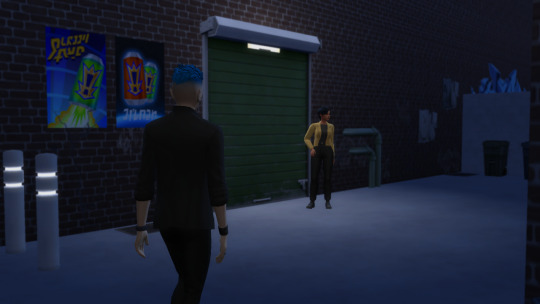
I made the alleyway we see here - it’s two entirely empty buildings sandwiched side by side on an otherwise empty lot in Oasis Springs. The only part I bothered to decorate was the alley itself because I knew I wasn’t going to use the rest of the area, but maybe we’ll revisit it sometime and I’ll finish the two buildings! I actually loved making this set and like how it turned out, LOL~
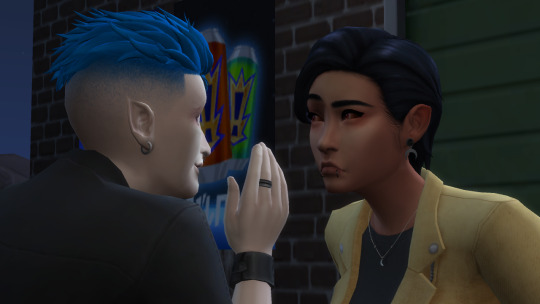
Then I just have whatever sims are involved in a scene interact with each other for ages until I feel like I have enough screenshots to make a scene. I usually have a vague idea of what’s going to be said in any given scene - especially the ones I actually planned out beforehand - but I get some excess screenshots to be safe. I try lots of different interactions and pause like every few frames to get interesting expressions and stuff, LOL. Lots of “Complain about Cold Weather” and “Give fake bad news” ...
3. CC/Pose making I don’t actually make my own CC for 2.B.A GM specifically (I’ve made a couple eyeshadows but I don’t use them super frequently) but there is a scene coming up in the future that I plan to make poses for. I have a very clear image in my mind that includes a lot of subtle expressions and very specific things that I doubt I could find poses for, so I’m gonna have to brave the terrifying landscape of blender in order to make it a reality. 😧
4. Getting in the zone I don’t have any sort of “ok, show time” ritual like some people do but I wish I did, because my motivation waxes and wanes so unpredictably. Some days I just don’t feel like doing anything, and other days I edit and write for 5 posts in a row! I am always listening to something though, usually music, every once in a blue moon a video with lots of talking. 5. Screenshot folder

UGH...
6. Captions I don’t do captions on 2.B.A GM posts, but for my city living gameplay I do! I keep them simple, because I don’t want to make it too much work for myself. Erin in San Myshuno’s style of editing is 100% based around ease, because I wanted something to post often that didn’t put too much of a strain on me. Verdana in white, typically 35-40 px, with a gradient border. Each sim we encounter has a different gradient color, usually based on their outfit or just the ~vibe~ I get from them. Erin’s gradient is Hot pink to ... gee, what would you call it. Sonic the Hedgehog Blue LMAO-- I chose that gradient because that’s the color of the overlay, which I’ll talk more about in the next section!
7. Editing My two ‘series’ - and I use that term loosely LMAO - have different editing processes, so I’ll try to summarize them both. Basically, for 2.B.A Grandmaster, I touch up the saturation and brightness depending on the scene. If it’s evening in the shots, I usually won’t touch brightness, and if it’s night, I might even lower it a bit for more accurate lighting! Once that’s done, I blur everything but relevant elements of a scene, usually the character we’re following or who is speaking. I have to select the character from the background manually which takes a bit, but other than that it’s very minimal.
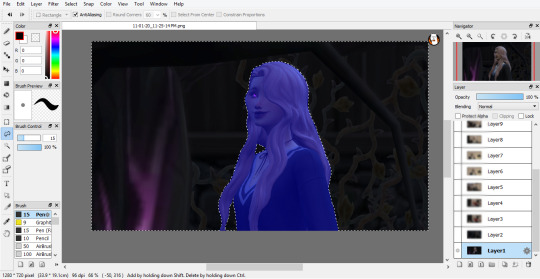
My shots aren’t super glamorous, but I prefer simple screenshots and actually being able to keep up with a story schedule as opposed to what happened with my last story. 😬 As for Erin in San Myshuno, barring captions which I only do when I feel it’s necessary, it’s literally just an overlay on otherwise untouched screenshots. 😭 I would do more, but again, it’s supposed to be an easy downtime sort of series for me so~

This goes over top all screenshots on the “Add” setting at 20% opacity. It brightens things up and softens them, as well as making the colors slightly more harmonious! If anyone wants me to go more in depth on editing, or maybe captions, please let me know! I’m happy to talk about it if it’ll help anyone, and I know that a lot of tutorials cover how to do stuff in Photoshop, whereas I use FireAlpaca (which is 100% free btw! It’s more of an art program, but not bad for editing) 8. Throwback!
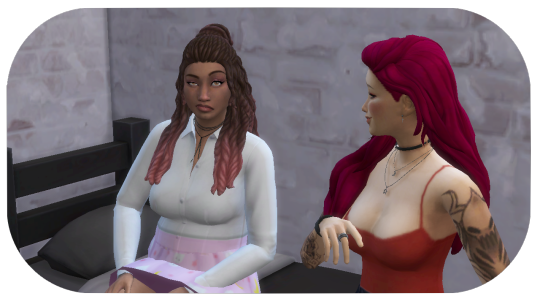
Oh boy, so this is one of my first posts on simblr. For starters, I didn’t know about camera mode at the time, so that’s the first thing I would change obviously LOL. 😬 The framing I did at the time was ... cute, but it makes the pictures feel kind of cramped and small in my opinion, so I did away with that for all of my later stories. Also, Amy and Gemma aren’t very well centered in this picture! Other than that, this isn’t actually terrible I don’t think, so aside from maybe blurring the background as I do on 2.B.A GM now, I wouldn’t change too much! Thankfully, I had observed other people’s stories before making my own on here for a little bit, so I wasn’t starting with absolutely no idea what to do, but I still think I’ve improved since I made these. 😊
This was a ton of fun!! If anyone has questions or wants more info on anything I covered in here, absolutely feel free to ask, and thank you so much if you actually read through all of this - I know I rambled for quite a while!! 🙏
20 notes
·
View notes
Text
okay, now that i've ran a few more sessions, i wanted to share some of what i love about this system so far!
in scum and villainy, players roll a number of d6s to do actions, taking the highest number rolled. 1-3 is a failure, 4-5 is a success with complication, and a 6 is a total success. the number of d6s is equal to the number the player has put into certain traits, but there are always ways to get more dice - via teamwork, accruing stress to push yourself, accepting a devil's bargain, or spending ship resources.
unlike a system like d&d, rolls are not simply a measure of success or failure. instead, they're a measure of how much trouble your action creates. it's a system that really embraces "failing forward." the action never stops, it just shifts. almost every single roll creates a new problem to deal with, obstacle to overcome, or clock to beat.
once i internalized that rolling is about trouble, NOT success/failure, i feel like the system really opened up for me. i simply don't ask for a roll if there isn't an interesting complication that could come out of it. if a PC wants to unlock a door, and there's nothing interesting that could happen upon an attempt/failure, then sure! you just open the door. we roll when it's interesting, not when it's just uncertain. the PCs *can* do almost anything, they are skilled professionals, they are savvy and knowledgeable and presumed competent. the rolls are about snowballing effects that happen as a result.
and that means that every roll has tangible stakes. due to the aforementioned resources players can use to gain dice, their successes often feel earned, as opposed to just dice luck. the players have a lot of tools at their disposal to ensure their success, but it all has a cost! and that cost adds to the overall feeling of actually achieving their goals.
what i also love is the freedom to just TELL my players what's up. there's a lot that's out in the open in a forged in the dark system. for example, the consequences of a roll shouldn't be a surprise to the player - they should be discussed before the roll as you set position and effect. the "assumed competence" component of gameplay also frees me up to just tell the PCs about the clues they find and the mystery they're unraveling. unlike with other systems, there's no chance that a bad roll means they miss something crucial and the game stalls out, because you're only rolling if a failure/success with a complication is more compelling than not rolling. players can also ask for a devil's bargain to gain an extra die, which is a complication that may happen immediately, or may happen in the future, but WILL happen regardless as payment for the die. again, this is another above-the-table negotiation that has been a lot of fun.
the game doesn't feel nearly as "GM vs PCs" as d&d and i think all of the transparency really helps with that, as well as the more collaborative, fiction-first mechanics of play.
okay, i'll stop rambling (for now). tl;dr: i am having a great time.
yesterday was technically the second session of my scum and villainy campaign, but it was the PCs' first job and the first time we really delved into the mechanics of the game and i gotta say, i really love gming the forged in the dark system. especially on the heels of dming dnd 5e since 2019.
34 notes
·
View notes
Text
Big Changes with V.14
So as I brought up in the pinned post, .14 is the current system in development for DDA and has added more changes in a single update than any other edition previously. Besides some general balance changes there’s been a lot of big updates which I’d like to go over here. This is by no means a comprehensive list, .14′s updates are just that big, but this will be me going over some of what I see are the biggest, most important, and most fun updates to the system.
Effect Changes
Effects now work differently than they did before. This is probably the biggest change to the core system and as such I want to talk about it upfront.
Now, when rolling for Positive Effects, the user rolls Accuracy and counts the Successes. Then the target(s) roll Health and count the Successes. For every number above the TN set by the Accuracy successes, add 1 to the duration of the buff.
Single-Target Positive Effects now automatically hit for 1 duration no matter what you roll for Accuracy/Health. Your friends no longer dodge your high-five buffs!
Multi-Target Positive Effects can still miss on a roll of 0 for Accuracy.
Melee tagged Positive Effects can target the user, allowing for self-buffing builds.
Positive Effects do not lower Dodge Pools anymore.
What does this mean? For one thing it means you want passable Accuracy but Accuracy is no longer the end-all-be-all of a support build because you don’t want it to be massively higher than your Ally’s Health stats. It also means being in Defensive Stance is the best way for you to buff in general, as opposed to Offensive Stance from before this update.
Negative Effects work effectively the same as before; roll Accuracy vs Dodge, count net successes for Duration. However, there are a lot of cool changes and new effects for debuffers to work with now. Be sure to check out the changes in the book. Personally I’m a huge fan of Lag and DOT and can’t wait to use them someday.
Tamer Orders
Tamer Orders are a spiritual successor to the old Tamer Qualities. When you hit a certain tier of power, you unlock the ability to use a Tamer Order. These are special types of things your Tamer can do and give amazing bonuses to your Digimon without relying on Charisma to Direct. These can range from applying a Taunt to an enemy, to healing your Digimon, to allowing your Digimon to use your Fateful Intervention. There’s a whopping 15 Tamer Orders, so I can’t fit them all here. Be sure to check them out in the book.
Instinct/InForce
Too long has Weapon been the only way to build a Digimon. Instinct now stands out as a defensive alternative which buffs your Digimon’s Dodge, Health, and Movement. And later on you gain access to InForces; powerful mechanics you can now utilize to your advantage. Instinct cannot be taken with Weapon, so be sure to choose wisely what kind of build you want.
Twin Partners
There is now a system for having two Digimon at once! They progress differently than normal partners, and have their own special rules. However despite being much weaker early in the game they can be the most powerful Digimon by the time you reach endgame. They also have access to combination attacks by default, so be sure to check the rules out.
Signature Move Update
Signature Move is no longer just a way to apply Certain Strike and Armor Piercing (which have been changed by the way, check those out!). Now it’s a big attack with extra damage, but at a cost; you can’t use it until your third turn by default. This means the Quality is worth taking even if you don’t have Certain Strike and Armor Piercing on the move.
Naturewalk/Element Master/Domain Control
Naturewalk has been updated to a proper tree of Qualities. Naturewalks now can grant special effects and bonuses, like Naturewalk: Dark granting Darkvision or Naturewalk: Water granting waterbreathing. But now there’s more than just fluff reasons to take the Qualities; and it all ends with Domain Control. Domain Controls are powerful Qualities which last for a set period, but allow your Digimon to do even more cool things. Be sure to check the tree out in the handbook. Personally I’m the biggest fan of Shadow Vale, but there’s something for everyone in here.
Negative and Free Qualities
Something that never got fully implemented before: now you can take a small selection of negative Qualities in order to get a bit of DP back on your build. These can be incredibly fluffy, or ways to just add a bit of randomness to how you play.
Free Qualities are all neutral for benefits; each has a tied in downside and are mostly for fluff. However they can be excellent ways to make your build more fun to play with. Both Free and Negative Qualities require GM permission.
Stage Bonus/Limitations
Stage Bonus is now implemented as a mechanic, mostly as a way to create smaller and non-DP related bonuses for certain things, as well as to limit the purchase of certain Qualities such as Weapon, Instinct, Armor Piecing, Certain Strike, and the like. Rookies can no longer just take 2 ranks of Weapon and Armor Piercing to punch well above their level. This was a very welcome addition for balance.
Mode Change/Burst Mode
I fully admit when I picked up DDA, I wasn’t as versed in terms. As such I missed Super Ultimate/Ultra as a stage and made Burst Mode the final stage of the system.
This is no longer the case. Ultra/Super Ultimate are now the highest stages, and Burst Mode is the capstone of the Mode Change tree. It allows you to effectively re-build your Digimon for a high cost, and depending on your Tamer Build grants extra special effects, many of which are callbacks to .12, AKA Rocket Tag Party Edition ™. Two Weapons are back on the menu!
Stealth Build Update
Sneak Attack, Hide in Plain Sight, and Shade Cloak have always been somewhat undervalued, as the former is very all-or-nothing, however the Substitute, Glamor, and Illusionary Overlay have all been added to give this type of build some more love. As of writing this post it’s one of the more recent updates to the system, so I haven’t had the chance to play with it much, but I look forward to it a lot.
Combat Monster Update
Combat Monster has been sort-of nerfed, upfront it’s more limited in how big its bonus can get. However, it’s now a tree type Quality. You can either go down the old Berserker path, or you can take the Brave Heart path. Brave Heart allows Tanks to take a special Stance and get more bonuses, and it caps with One for All, which upon activation shares your Combat Monster bonus with all your nearby allies. This has made a very teamplay based Tank setup which has been very welcome in .14.
Quick Healer Update
Quick Healer has been updated as a line; Second Wind will allow your Digimon to heal themselves mid-combat, thus giving more reason to dip into the tree than just out of combat usage. Regenerator has also been adjusted, be sure to check it out.
Summoner Update
Summoners can now create much more specialized minions; ranging from one big one to smaller, scout-based minions. This creates amazing versatility to a previously fairly basic type of playstyle, and I encourage everyone to check it out.
Range Update
How far you can attack has been a big concern in previous editions. With .14 there is a hard defined limit for your Digimon’s range, instead of it just being a practical limit. This is adjusted based on your stage and Accuracy, be sure to look things up before blasting away. This has been an excellent way to stop people from just sitting back and using Ranged Strikers to win.
And More!
There is so much to go over with .14, and I’ve barely scraped the surface (another thing to check out for example is the Cross Counter Quality). It’s late while I’m typing this up, so I’m sorry if I’ve missed anything major, but I cannot go on enough about how much I love the changes to the system. If you haven’t picked up .14 yet, please do as soon as you can.
Coming Soon
There is also a Quick-start guide in the works, made to simplify things a bit for quick reference. The book is amazingly detailed but we’re doing our best to make it easy to look up what you need as well. Stay tuned for that update.
10 notes
·
View notes
Link
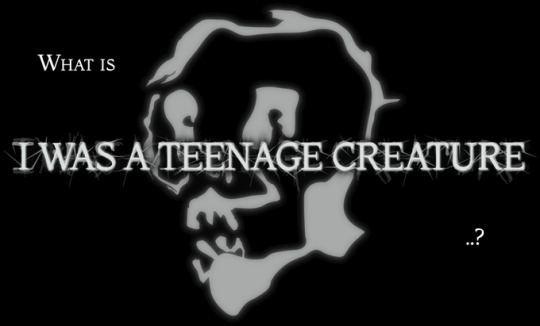
What Is IWATC? Click here to download a free QuickStart!
I WAS A TEENAGE CREATURE is a narrative-focused, urban fantasy tabletop roleplaying game that emulates a young adult paranormal TV show such as Buffy the Vampire Slayer, Teen Wolf, or even the Dresden Files. What keeps fans of this genre coming back for every single episode of the show? Is it the monster of the week...or the angst and drama of the main characters' lives? An exciting paranormal threat or creature certainly helps, but it's mostly the audience wanting to witness the main characters go through the emotional wringer (and hopefully emerge generally victorious on the other side.) In this game, that's exactly what happens...it's actually the point of the game.
In IWATC, it doesn't matter how strong the werewolf is, or how fast the vampire is, or how beautiful the fae is...what matters is how each of these characters feels, WHY they're doing something, not just how capable they are of doing it. When the monster of the week invades Signal Lakes High School grasping the Hunter guy's mom by the throat, of course he attacks it...but why? Out of LOVE for his mother, or RAGE at the monster for threatening her? FEAR he's about to lose her? Or maybe he's PROUD to have learned the family business well and proves it by saving her all by himself! The Player tells their character's Story in this game, choosing why they do the things they do and how they try to do them.
The I WAS A TEENAGE CREATURE core gamebook is the complete roleplaying game, all in one ~350 page book. This epic tome of urban fantasy will contain everything needed to tell gripping and exciting young-adult paranormal drama stories with in-depth characters that have built-in emotional backgrounds and motivations. The book includes an introduction and an overview of the mechanics; an extensive character creation section that includes the character's base emotional matrix; explanations of the various Creature Types and their paranormal abilities; the metaphysical "laws" of reality for the setting; the game mechanics rules; GM sections on guiding character creation, running the game, creating scenarios & campaigns, and customizing the game's setting; the base setting of Signal Lakes; and 23 pre-generated characters along with three ready-to-run scenarios or "episodes" of the IWATC "show." The game also includes both a table of contents and extensive indexes to make locating desired information easy, as well as a variety of appendices for looking up point costs, mechanical effects, converting the crunch-light narrative mechanics into reliable dice modifiers, and more!


IWATC uses a simple Success-based d10 system where the Players roll a number of d10s equal to their character's appropriate stat, perhaps plus a few dice for a relevant Skill. Each die generates -1, 0, 1, or 2 Successes; if the roll's total Successes are equal to or greater than the roll's Difficulty, the character successfully performs the action. There are only four stats, covering ANYTHING a character might try to do: Might, Reflex, Insight, and Codex. Skills are broad categories that can add more dice to any roll, as long as the Player tells their character's story in a way that makes using the Skill make sense. I WAS A TEENAGE CREATURE is all about making the characters and their Story as awesome and dramatic as possible, which means that creative story-telling gets well rewarded!
So, the Player rolls some number of dice when their character tries something, but what do their emotions have to do with it? The characters' Emotions determine how many Successes each die generates. Each character's Emotions are arranged in four opposing pairs, with each pair's intensity rated from 1-10. When they attempt an action, a character chooses which of their Emotions is motivating that action, then rolls the appropriate number of d10s against that rating. Rolls motivated by a Positive Emotion generate 1 Success for each die that rolls higher than the rating, 2 Successes for rolls of 10, zero Successes for rolls equal to or less than the Emotion's rating, and -1 Success on rolls of 1, removing a Success from the combined total.
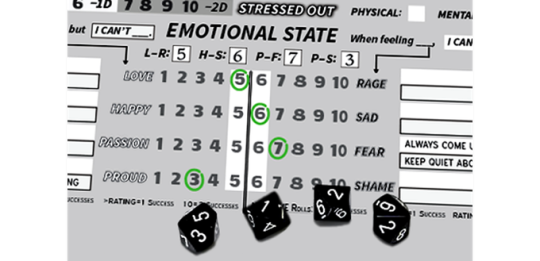
If this is a PROUD roll, it only has 1 Success, but if it's a SHAME roll, it has THREE Successes!
Conversely, actions motivated by Negative Emotions want to roll low, generating 2 Successes on rolls of 1, a single Success for other numbers less than the Negative Emotion's rating, zero Successes for rolls equal to or higher than the rating, and removing a Success for rolls of 10. In the picture above, if a monster is attacking Dylan's father and he made this roll out of LOVE for his father, he got no Successes and failed his action! But if Dylan made this roll out of RAGE at the monster for threatening his father, he got THREE Successes! However, the Player does have to choose which Emotion their character is using before they make their roll, of course.
This is why it doesn't matter how _____ a character is in I WAS A TEENAGE CREATURE, as long as they're ____ enough. On an urban fantasy TV show, the audience is well aware that the Hunter is skilled and the Fae is cunning and the Ghost moves in an eyeblink...it's why they're doing the amazing things they do that counts! The audience is watching to see how the characters respond to the dire situations they find themselves in; IWATC is about those responses and how the characters feel, not about how powerful they are.

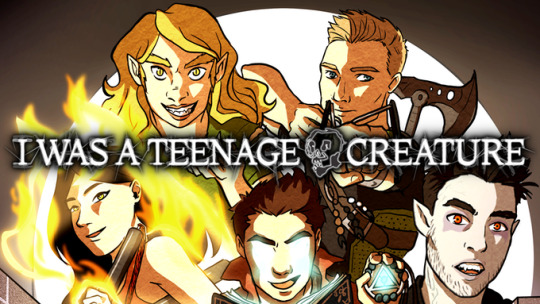
I WAS A TEENAGE CREATURE is set in Signal Lakes, the suburb immediately south of Miami...which happens to be the western tip of the Bermuda triangle. Paranormal creatures and forces are drawn there, with new ones showing up all the time. The Player Characters in IWATC can be any of ten different Creature Types, each associated with one of the game's eight Emotions. The ten Creature Types included in the base game are:

Click here for more details on Casters

Click here for more details on (Eros)cubus

Click here for more details on Fae

Click here for more details on Ghosts

Click here for more details on Humans

Click here for more details on Hunters

Click here for more details on Kitsune

Click here for more details on Psychics

Click here for more details on Vampires

Click here for more details on Werewolves
Character creation in IWATC uses a point-based system, so Creature Types that start with multiple paranormal Abilities, like Vampires and Werewolves, cost more than those that require points to be spent on customization, like Casters and Fae. Character Creation Points are also spent on Skills, Capabilities, and Feeling Factors, which are aspects of a character's personality or history that affect their starting Emotional State, such as a CHEERFUL character having a lower HAPPY-SAD rating, or a character who has suffered a LOSS having a higher rating. Players can build their characters any way they want, taking whatever Traits they feel describe the character they want to play.
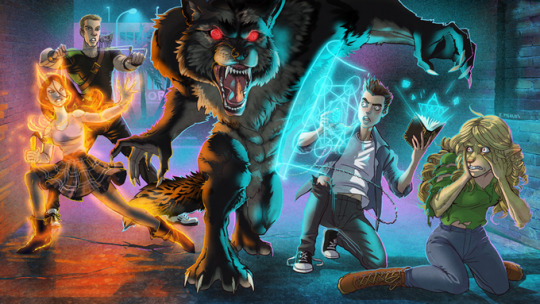
Kickstarter campaign ends: Sat, March 21 2020 4:59 AM UTC +00:00
Website: I Was A Teenage Creature
200 notes
·
View notes
Text
Methods for Creating Robust RPG Characters From an Actor’s Perspective
I know I don’t post a lot at all, but I’m trying to be better about that. So instead of empty promises and some Assassin’s Creed screenshots, here’s some Real Content! This one’s for all you RPG’ers who might want some advice on character writing. Hope you enjoy it.
For context, I am an actor in Northern California with professional training and seven years of theatre experience. I’m in college currently pursuing a theatre degree. I have been running rpgs for about a year now, and I am the forever game master (GM) for my gaming group. With that in mind, know that the suggestions in this article come from a place of strong knowledge and love for the art of theatre, and from personal experiences, both onstage and at the gaming table. I have a lot of particular thoughts regarding aesthetic philosophy, specifically as it relates to acting and theatre art, but I’ll try to keep those to a minimum.

1. Start With Your Gameplay Vision
This method focuses on the player’s gameplay preferences first and builds the personality to accommodate that. What do you want this character to be like in a social situation? Do you want a suave talker who can charm his way into trouble and then bluff his way right out of it? Or do you want to be the quiet, brooding type who lets her allies talk things out whilst backing them up by looking intimidating? Similarly, consider how you want to approach combat. Whether you’re a guns-a-blazin’ type player or a stealthy assassin doesn’t matter; the most important part is making that concrete decision and then creating a reason for it.
For example, if you want your character to be a gunslinging, animal-taming bard, decide why they fight that way. Why do they like guns, and how did they learn to shoot? When did they discover their love of animals, and when did they practice the skills which enabled them to tame creatures? With each additional answer, keep adding to the backstory and make sure that everything you add to it stays consistent with its ability to facilitate your gameplay preferences.Keep asking and answering these kinds of introspective questions about your character until you feel comfortable with that creation.
I recommend this method for beginning players and game masters because it allows one to write up a character based on something you’re already excited about. I’ve found that this method works especially well for Dungeons and Dragons, but it’s a perfectly effective method for other, more role-play focused games like Call of Cthulhu or Vampire: the Masquerade.
The beauty of creating a character this way is the simplicity; the player only needs to consider whether or not every added detail to the character’s personality and backstory is consistent with their desired playstyle. There is no need to worry (too much) about the lore of the game world. The biggest drawback, however, is that this method encourages players to think about actual play in a much more meta-minded manner, as opposed to focusing primarily on immersion and role-play, especially for new players. You might find that you or your players will only play this character so far as to create an opportunity to roll dice. This is totally okay, by the way; there is nothing wrong with hungering for a good dice roll. It’s just something to keep in mind.
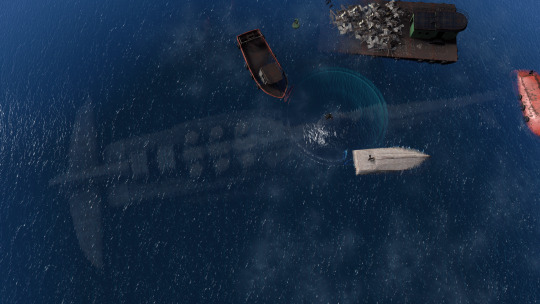
2. Find an Environmental Anchor
You may find the previous method to be too basic or meta or for whatever reason not your desired method for character creation; that’s fine! Sometimes when you start a new character, you don’t have the slightest idea about what you want to do in combat or maybe you don’t want to build a character based on class or combat role. No matter what, this method is totally focused on immersion into the game world and nothing else.
First, speak to your GM about the setting and theme of the game. Try to get as much information as you can about the world and its lore, and then pick something you like as an anchor. For example, if there is a rugged mountain range in a high fantasy setting that you like the concept of, consider making a connection to it with the information you have; is your character from there? Do they want to go there? Did something happen to them whilst travelling through the mountains? Whatever it is, define a clear connection to that place (assuming it works with your game master’s world and lore, of course) and then work from there, asking “why” and “how” along the way to smooth out those rougher details.
Environmental anchors don’t even need to be related to the geography, either! For example, if you’re playing a sci-fi setting where your character lives on a colonial planet, find out what that culture is like. Why is there a colony? What government funded the development of this colony? How do people feel about their leaders and what do they do about those feelings? Acquire any and all information about the people and their culture as you can (assuming your GM shares that with you) and then consider how you want your character to exist in that context. If it’s a religious society, define whether or not your character is religious and how they feel about religion. Do they follow the same religion as everyone else? How has religion affected them in the past? These kinds of questions help you to define how your character acts and feels in the context of the game world without focusing on the different aspects of gameplay or game balance. You’ll definitely find your fighting style along the way, don’t worry.
The biggest downside to using this method as a player is that you need to bug your GM a lot. Chances are they’ll be more than happy to help, especially if they’ve built the entire game world from scratch. But remember, depending on the person, you might not get a lot of information because it’s all an elaborate secret, or they might just not have that information available for you. However, the silver lining is that in asking your game master specific questions about the world, their creative wheels start to turn as they ponder these questions. I’ve found that this usually leads to the GM creating a far more robust and detailed land than they would have done otherwise. In any case, be kind and patient with your questions.

3. Define Personality Traits
Maybe you’re an experienced player and want to try a different method of character creation, or maybe you’re a new player who wants to focus on role-playing a particular archetype, but you have yet to define their more nuanced personality traits. This method is perfect for building a personality, and then writing your backstory to accommodate that.
Like the other two methods listed here, the most important thing is to decide on a concrete center for your character concept, regardless of what it is. If you want to play a character who is a brave and honorable warrior, start with that. Why do they value bravery and honor? Was it ingrained in them during childhood or did they learn those values later in life? Just those two questions can give you a lot of creative room with which to work. Keep asking questions about the reasons for your character’s attitudes and the way they react in different situations.
I personally use this method a lot in conjunction with finding an environmental anchor. You don’t have to, but if you choose not to create a character who is tightly tied to the game world in some way, you run the risk of creating a character in a contextual vacuum. I’ll expand more on this idea at a later date, but the key thing to remember is that people, and by extension characters, do not exist in a vacuum. There is always a social and an environmental context which affects how your character develops. Once you’ve used this method to come up with a good personality for your character, be sure to work with your GM to implement them into their game world as smoothly as possible before play begins.

4. Assist Your Players
This one is for all the game masters out there. I find that it is incredibly helpful and important to assist players in character creation, especially if they are struggling. Asking your players questions and providing suggestions which they themselves may not have thought of goes a long way in helping them develop a character with some real depth. In my experience, this collaboration also helps immensely with prompting players to create more intriguing backstories.
Communication is incredibly important (again, I plan to elaborate on this subject in a future post) and as a GM, character creation goes a lot smoother when you inform your players about the setting as soon as possible. Keep them updated as things change in your planning so they can change their ideas in time, if need be.
The biggest pitfall with this method for both players and game masters is the risk of allowing the player's creation to become the GM's creation. Too many suggestions for backstory plot points or personality traits can smother the player's creativity and lead them to play a character which actually isn't their own creation, and they might not be happy about that.
Personally, I like giving my players as much agency as possible, so i tend to keep my suggestions to a minimum and focus on asking my players questions about their character. However, if your players enjoy taking your suggestions and everyone's having fun, you don't need to worry.
One Last Thing…
Remember that your character, especially if you’re a player, is your vessel through whom you may freely express yourself. Stay true to whatever your vision is and create something that you actually enjoy, even if it takes a little bit more time than you’d expect. Playing tabletop games is about having fun and sharing a narrative experience. Don’t worry too much about if your character is “right” or “interesting enough” or “different enough” from your own real personality; that stuff doesn’t matter. As long as you’re all having fun, you’re doing it right.
Be kind to each other and stay healthy.
#fallout#falloutnv#fallout3#fallout4#TES#the elder scrolls#gaming#pcgaming#pc games#skyrim#fallout screenshots#skyrim screenshots#character aesthetics#dawnguard#role-playing#rpg#ttrpg#tabletop#tabletop gaming#advice#article#opinion#game master#gm#dungeons and dragons#d&d#call of cthulhu#character development#writing#dungeon master
31 notes
·
View notes